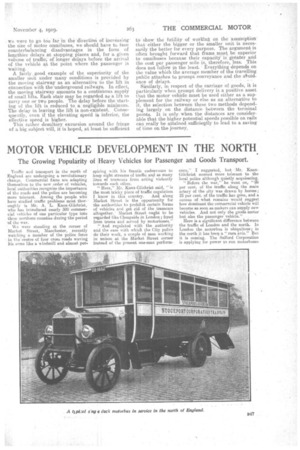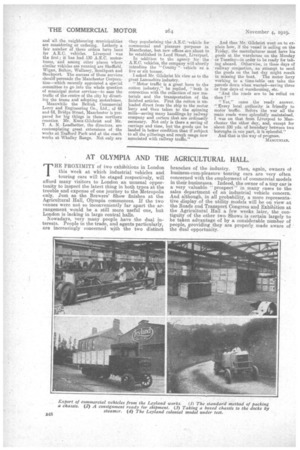MOTOR VEHICLE DEVELOPMENT IN THE NORTH
Page 19

Page 20

If you've noticed an error in this article please click here to report it so we can fix it.
The Growing Popularity of Heavy Vehicles for Passenger and Goods Transport.
Traffic and transport in the north of England are undergoing a revolutionary change. Commercial fitms are adapting themselves to the new order of vehicles, local authorities recognize the importance of the roads and the police are becoming more tolerant. Among the people who have studied traffic problems most thoroughly is Mr. A. L. Knox-Gilchrist, Who has introduced nearly 500 commercial vehicles of one particular type into these northern counties during the period -of the war.
We were standing at the corner of Market Street, Manchester, recently watching a Member of the police force in the centre of four cross roads waving his arms like a windmill and almost per
spiring with his frantic endeavours to keep eight streams of traffic and as many lines of tramcars from acting violently towards each other.
"Here," Mr. Knox-Gilchrist said, " is the most tricky piece of traffic regulation I know in this country. And along Market Street is the opportunity for the authoritiei to prohibit certain forms of vehicle.s and get rid of the tramcars altogether. ' Market Street ought to be regarded like Cheapside in London; freed from trams and served by motorbuses."
" And regulated with the authority and the ease with which the City police do their work, a couple of men working in unison at the Market Street corner instead of the present one-man perform
ance," I suggested, but Mr. KnoxGilchrist seemed more tolerant to the local police although quietly acquiescing. "Before the war," he went on, "99 per cent, of the traffic along the main artery of the city was drawn by horses 25 per cent, of the traffic has gone, and a census of what remains would suggest how dominant the commercial vehicle will become as soon as. makers can supply new vehicles. And not only the goods motor but also the passenger vehicle."
Here is a significant difference between the traffic of London and the north. In London the motorbus is ubiquitous; in the north it has beeu a "rat's avis.7 But it is coming. The Salford Corporation is applying for power to run motorbuses and all the neighbouring municipalities are considering or ordering. Latterly a fair number of. these orders have been for A.E.C. vehicles. Liverpool was the first ; it has had 130 ARC. motorbuses, and among other places where similar vehicles are running are Sheffield, Wigan, Bolton, Wallasey, Southport and Stockport. The success of these services, should persuade the Manchester Corporation—which recently appointed a special committee to go into the whole question of municipal motor services—to ease the traffic of the centre of the city by diverting the trams and adopting motorbuses.
Meanwhile the British Commercial Lorry and Engineering Co., Ltd., of 66 and 68, Bridge Street, Manchester is prepared for big things in these northern counties. Mr. Knox-Gilchrist and Mr. T. A. N. Leadbetter, the directors, are contemplating great extensions of . the works at Trafford Park and at the coach works at Whalley Range. Not only are theypopularizing the ARC, vehiole for commercial and pleasure purposes in Manchester, but new offices are about to be established in Lord Street, Liverpool.
In addition to the agency for the A.E.C. vehicles, the company will shortly introduce the " County ' vehicle as a five or six tonner.
I asked Mr. Gilchrist his view as to the great Lancashire industry.
"Motor traffic is a great boon to the cotton industry," he replied, " both in connection with the collection of raw materials and . the transportation of the finished articles. First the cotton is unloaded direct from the ship to the motor lorry and then taken to the spinning mills—saving many handlings by railway company and carters that are ordinasily. necessary. Not only is there a saving of carriage and time, but the goods Can be landed in better condition than if subject to all the pilferings and rough usage now associated with railway traffic." And then Mr. Gilchrist went on to explain how, if the vessel is sailing on the Friday, the manufacturer must have his goads at the warehouse on the Monday, or Tuesday—in order to be ready for taking aboard. Otherwise, in these days of railway congestion, an attempt to send the goods on the last day might result in missing the boat. The motor lorry working to a time-table can take the parcels down when wanted—saving three or four days of warehousing, etc.
"And the roads are to be relied on then ? "
"Yes," came the ready answer. "Every local authority is 'friendly to motor traffic. Before the war all the main roads were splendidly maintained. I was on that from Liverpool to Manchester the other day, and except for about 100 yds. of boundary between two boroughs in one part, it is splendid."
And that is the way of progress. MANCUNIAN.


























